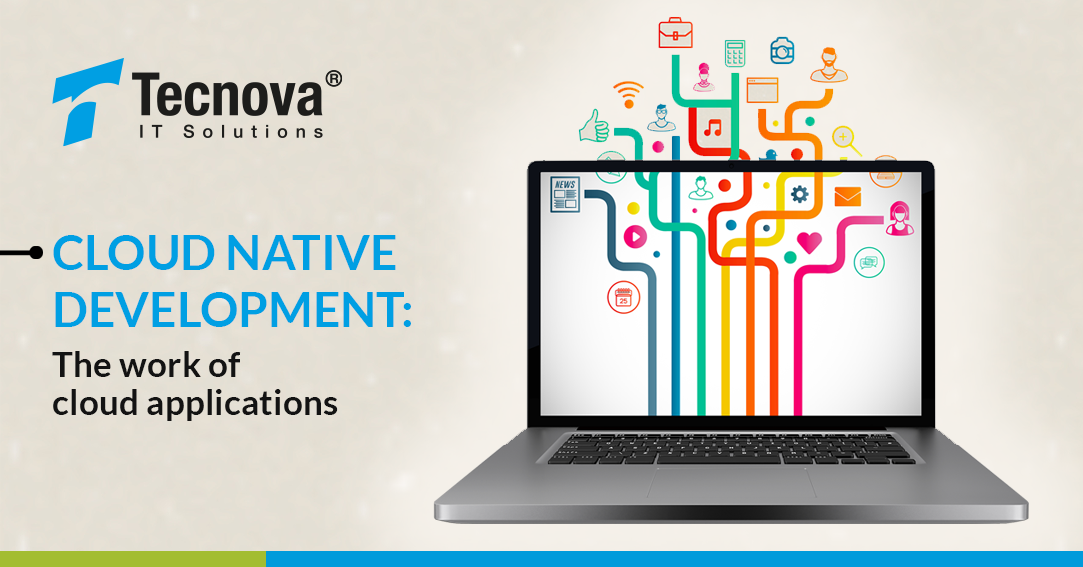Cloud Native Development: The Work of Cloud Applications

In the last few years, software development has made major strides. Programmers have obtained tools that have been enablers of their duty as developers such as available services in the Cloud.
One of the principal possibilities the work on the Cloud has brought, is the faculty of creating, developing and testing apps directly from these digital spaces, whether they are public, private or hybrids. This approach is also known as Cloud Native Development.
In this following Tecnova article we will be delving deeper into this set of services.
What it is and how the approach of Cloud Native Development works
Firstly Red Hat talks about it as “(…) a way of accelerating creation of new apps, improving the existing ones and connecting them all.”
Services produced in this way help the companies to stand out in their field’s competition, due to the quickness in which the development phase is produced, that also enables the innovative work in the app’s final design.
In this method, Software architecture is managed from a Cloud server also called Serverless.
The website VMware gives us a brief explanation about some of the key items when working with Cloud Native Development.
DevOps is the combined effort between the apps developers team and the TICs team with the main goal of achieving high quality software. Thanks to DevOps software scheduling, testing, launching and updates phases are reached rapidly.
The Continuous Delivery allows to make progressive changes to the app in an automated manner, being able to bring forward launching dates and updates.
The Use of Microservices is an architectonic approach in which a software is created from the development of small -micro- services that together complete the final product. Each microservice has enough autonomy to be implemented, updated, scaled and resumed without interfering with the other microservices.
In the Containers a single instance of the Operating System of the project can be divided into different containers that have their own resources. This feature facilitates the implementation of microservices in the project.
The Native Security of the Cloud protects the companies from digital threats coming from others, focusing in three points:
- Repair the vulnerable software as fast as the updates allow it
- Regularly restructure the servers and apps from a well known stage
- Frequently alternate user credentials
Cloud Native Development in practice
The use of Cloud Native Development offers different advantages related to time, portability and production costs. According to the data delivered by Weave Works, we highlight the following benefits.
Scalability without infrastructure intervention
The Cloud Native offers an almost unlimited scaling of computing, storage and other resources. This same scalability allows companies to modify the software with no big changes in their infrastructure.
Simplicity in changes restitution
Thanks to GitOps and DevOps modeling practices there are low cost methods to reverse programmatic changes. This option facilitates the innovation path and improvement in the service’s quality, due to the simplicity of testing on a trial basis -or test- and failure, not having to take the risk of not recovering the code to its previous condition/status.
Productive Speed
In the development process of an automated shape, use is made of CI/CD pipelines for testing changes in the software code. Using this method is possible to modify and test its functionality in a short period of time.
Reduced Costs
Cloud Native technology offers payment plans by the specific use of the service model. This enables a reduction in infrastructure expenses that can be placed instead into the development of the Software. Also, the costs associated with hosting are also reduced.
Cloud Migration
One of the reasons for the use of Cloud Native Development is the amount of tools and suitable options with different Clouds. Besides, project services that are being developed in Cloud Native Development have the advantage of Cloud migration if it is required, always that its architectural design allows it. This can be seen as changing to better offers in a different Cloud with other infrastructure or because the app design requires a multiple Cloud infrastructure.
More information:








